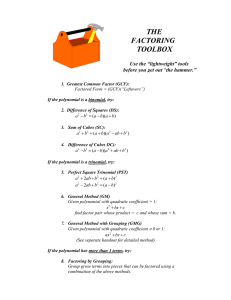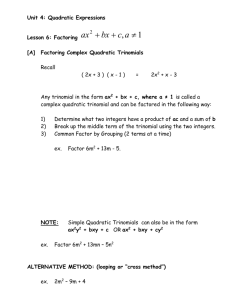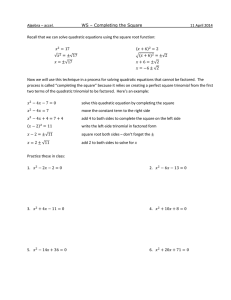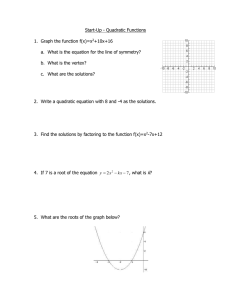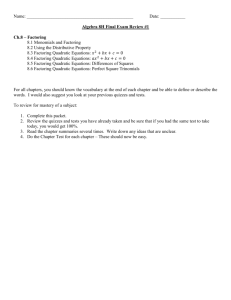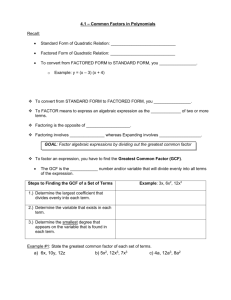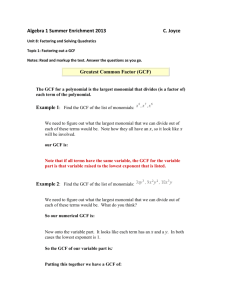7.6 Factoring: A General Review 7.7 Solving Quadratic Equations by
advertisement
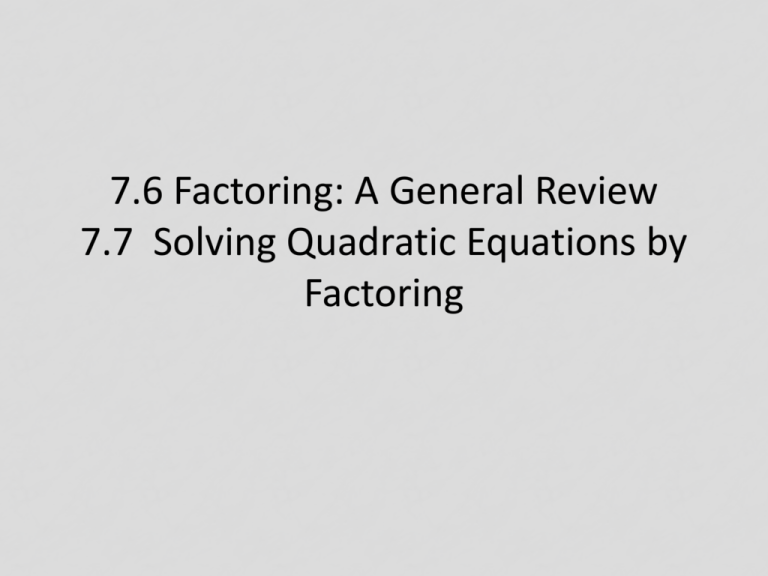
7.6 Factoring: A General Review 7.7 Solving Quadratic Equations by Factoring Checklist for factoring polynomials of any type. • 1. If the polynomial has a greatest common factor other than 1, factor out this GCF • 2. If the polynomial has two terms (binomial), check to see if it is a difference of two squares or sum/difference of two cubes and factor accordingly, if it is a sum of squares it will not factor • 3. If the polynomial has three terms (trinomial), then either it is a perfect square trinomial, which will factor into a binomial squared, or it is not a perfect square trinomial, in which you can try to factor using methods developed in 7.2 and 7.3 • 4. If the polynomial has more than three terms, try to factor by grouping • 5. As a final check, see if any of the factors you have written can be factored again or further. If you have overlooked a common factor you can catch it here. Remember, some polynomials cannot be factored, in which case they are considered prime. Practice 3 x 27 x 4 3 2 x 20 x 50 x 5 4 y 36 y 5 3 3 15a a 2 2 4 x 12 x 40 x 4 3 2 3ab 9a 2b 6 7.6 1-74 odd # 68. ( x 5) 2( x 5) 3 2 # 74. (3 x 1) (3 x 1) 3 # 66. 3 y 81 y 4 #58. 16 x 16 x 1 2 7.7 Solving Quadratic Equations by Factoring This will be the exact same thing that we have been doing, except Now there will be an equals sign and another expression on the other side, the overall goal is to make one side of the equal sign a zero and then factor the remaining side. Then use what we call the ZEROFACTOR PROPERTY Definition: Quadratic Equations • Any equation that can be put in the form ax2+bx+c=0, where a, b, and c are real numbers (a cannot equal 0), is called a quadratic equation. The equation ax2+bx+c=0 is called standard form for a quadratic equation. Zero-Factor Property • Let a and b represent real numbers. If a x b =0, then a=0 or b=0. • Thus if we factor x2+5x+6=0, we are left with (x+2)(x+3)=0. Because there is multiplication and our product is zero, one or both factors, must indeed be zero themselves, thus we make the equations x+2=0 and x+3=0 and solve for x. This will then provide the only values for x that will force the quadratic equation to equate to zero. Solve the quadratic equation 2 x 5x 3 2 Solve 16a 25 0 2 What to do when a GCF is factored out and the GCF is just a constant. 2 x 10 x 12 2 What to do when the GCF has a variable term. 5 x 2 x 2 • On occasions you may have to multiply something out and combine like terms before you can factor. (initially the problem may actually look pre-factored but it is not because the other side is not a zero). x(2 x 3) 44 Example x(13 x) 40 Harder example ( x 2) ( x 1) x 2 2 2 Solve: this example is not a quadratic, (we call it a cubic) but it can be solved in the same manner 4 x x 5x 3 2 Section 7.7 1-84 odd.
